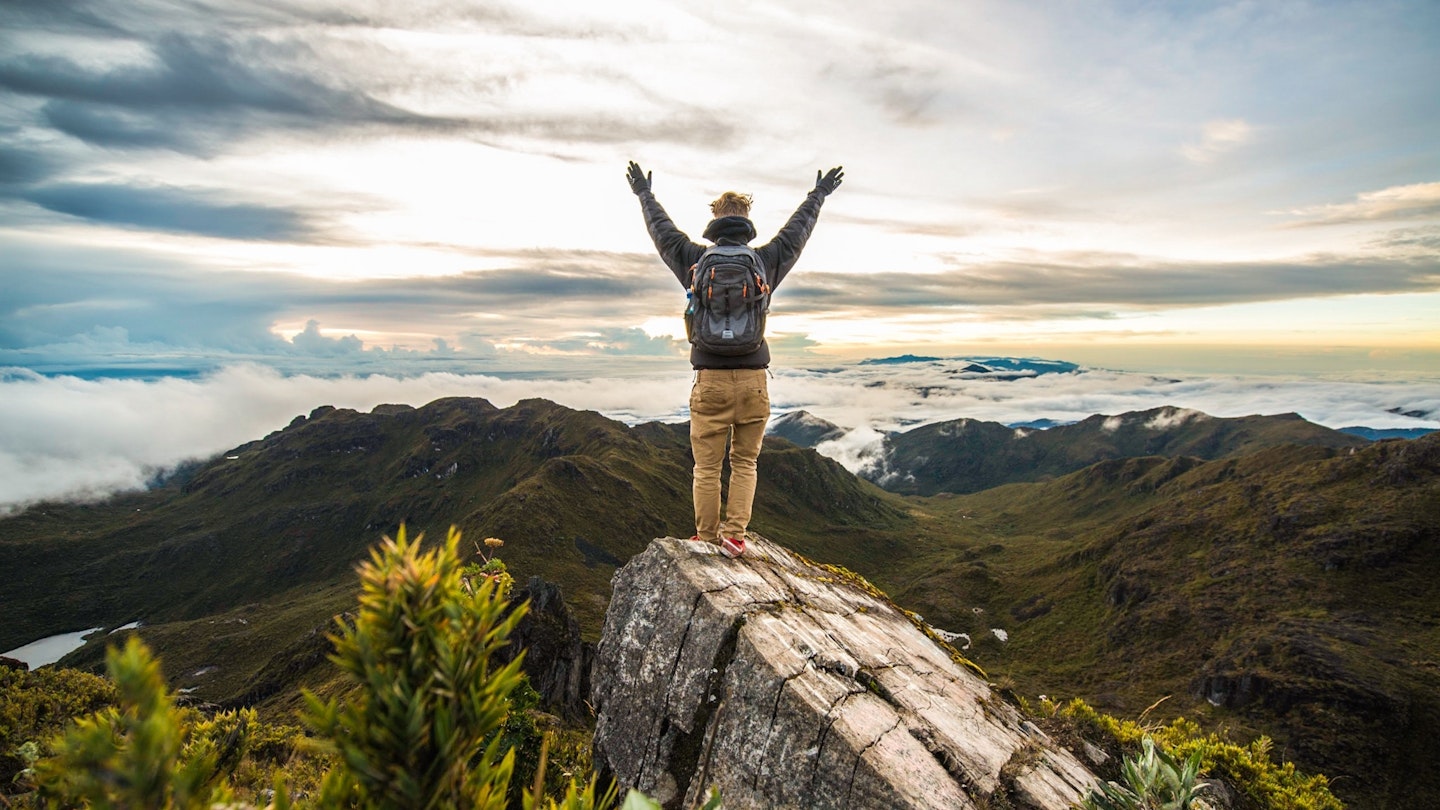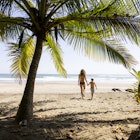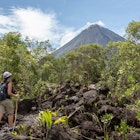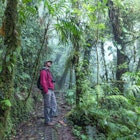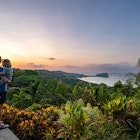From popular jaunts through the coastal rainforest to arduous climbs to mountain peaks, Costa Rica has vibrant and varied landscapes that offer endless opportunities for hiking.
Indeed, sometimes there’s no other way to reach that volcanic crater, swim in that waterfall, or spot those rare birds – except under the power of your own two feet. Fortunately, you don’t have to be an expert, as there are trails to suit all skill levels. They are usually well-marked, and guides are often available. And if you are an expert, you’ll find plenty of challenges as well.
The most popular hiking trails can be crowded during the high season. But there’s almost always a path less trodden somewhere nearby. So lace up your boots and grab your walking stick: here are the seven best hikes in Costa Rica.

1. Parque Nacional Cahuita
Best for wildlife and pristine beaches
6.5 miles (10.4km) one-way, 2 hours, easy
Outside the village of Cahuita, the eponymous national park is a fantastic and popular hiking destination, blessed with coastal rainforest, mangrove swamps, pristine beaches and some very vocal troops of howler monkeys. There are two entrances to the park – one at Kelly Creek, near the village, and one at Puerto Vargas, which is 3.5km (2.2 miles) down the road. A single hiking trail runs along the coastline, connecting the two entrances. Most hikers opt to hike one way and catch a lift in the other direction. Buses ply this route every 30 minutes, or it’s also possible to flag down a car heading toward Cahuita.
The trail is flat and easy, with one river crossing (which can be a submersive experience at high tide) and two swimming beaches. The hike’s rewards are plenty, especially the abundant wildlife, which is remarkable for a trail that is so easy to access. Keep your eyes open for sloths, monkeys, coatis, snakes, iguanas and loads of water birds.
At the Puerto Vargas entrance, there’s a 2km (1.2-mile) boardwalk – the Cavitas Trail – through forest and mangroves. If you start at Kelly Creek, this will be the last leg of your hike. This portion of the trail is wheelchair accessible.
2. Parque Nacional Barbilla
Best challenging hike
3.5 miles (5.5km), 4 hours, difficult
About 22km (14 miles) south of Siquirres, Parque Nacional Barbilla is not for the timid, as the hike is challenging and facilities are nonexistent. But if you want to follow untrodden trails and learn about the indigenous Cabécar people, it may be for you. The hike delves into the humid lowland forest, rich with wildlife and the rushing Río Danta, which tumbles over two magnificent waterfalls on your way.
The trail is muddy and steep, with multiple river crossings. It also requires an indigenous guide, whose insights on the Barbilla area and the Cabécar culture are bound to be a highlight of the hike. Contact the Barbilla ranger station (tel: 506-2200-5224) in advance to make arrangements for a guide.
Incidentally, Parque Nacional Barbilla is one segment of a newly developed thru-hike known as the Camino de Costa Rica. This epic coast-to-coast journey traverses the country, following rural roads and connecting small villages and indigenous communities. Lodging is available at simple guesthouses and with local families along the route. The goal is to give curious travelers a chance to visit lesser-seen cultures and communities in a mutually-beneficial and purposeful way.
Want some help? Let Elsewhere plan your next trip.

3. Arenal to Monteverde
Best multi-day trek
15 miles (25km) one-way, 2 days, moderate to difficult
Hordes of travelers make the journey from Arenal to Monteverde by car, bus or on the efficient taxi-boat-taxi ensemble. Fewer travelers take the most direct route, which can only be done on foot. Red Lava Tours offers this challenging and rewarding hike, which traverses the lush valley of the Río Caño Negro, then climbs into the mountains of the Cordillera de Tilarán, following ancient but little-used trails through the forest.
It’s very steep at times: expect 1000m (3280ft) of elevation gain. But the scenery is spectacular, with views of forested mountains all around – and especially that magnificent fiery mountain, Volcán Arenal, with its namesake lake in the foreground. A highlight is spending the night in a remote and rustic mountain cabin, where your guide prepares dinner over a wood stove. The second day of hiking is mostly on rural roads until you reach the outskirts of the village of Santa Elena, and the end is in sight.
4. Parque Nacional Volcán Tenorio
Best for unique geographical features
3 miles (5km) roundtrip, 2 hours, moderate
Although this national park is named for the inactive volcano therein (which you can glimpse from the trail), it is best known for the heavenly blue waters of the Río Celeste. This is one of several rivers in northwest Costa Rica that have particles of certain volcanic minerals suspended in the water, which reflect a gorgeous milky blue hue.
The main hiking trail in the Parque Nacional Volcán Tenorio shows off the true blue river in various forms, most famously, the stunning Río Celeste Waterfall. Further along, there’s a beautiful blue lagoon, as well as the teñidores, which is the junction of two rivers where the water turns blue. It’s a relatively short hike, but it’s a pretty spectacular – and unusual – display by Mother Nature.
The first part of the hike (up to the waterfall) is an easy amble on a partially paved trail. Beyond the waterfall, the trail gets more rugged, and it’s often muddy. Note that heavy rains affect the color of the river, so it’s worth checking the conditions before making the hike. Visit the national park’s official Facebook page or ask your lodging to call the ranger station for an update.
5. El Miro Ruins, Jacó
Best urban hike
1.2 miles (2km) one-way, 1 hour, easy
Need a break from the beach? This unique hike is a fun way to while away a few hours when you’re in Jacó. It is a short and well-marked trail that leads from the main street in town up to a half-built hotel (or mansion, depending on who you ask).
About halfway up, a wide balcony provides an impressive vista of Playa Jaco. You might be tempted to linger (and you should, for a while), but do continue up to the hotel, an elaborate construction with pillars and balustrades. The exterior has become a tableau for colorful graffiti and oversized murals.
The interior invites exploration and speculation about what happened to this place. Of course, the best reward is the spectacular panorama, which is particularly lovely at sunset. Just be careful on the way down, as there are no lights on the trail. If you want to change it up, there is also an alternate route down that ends up in Playa Hermosa.

6. Nauyaca Waterfalls
Best waterfall hike
7.5 miles (12km) round-trip, 3 hours, moderate
There are plenty of waterfalls in Costa Rica – and even more hikes – but they don’t always come together for such a perfect “waterfall hike” as they do at Cataratas Nauyaca. About 10km (6 miles) inland from Dominical, the trail follows the scenic Río Barú through dense rainforest, where you’re likely to spot birds and monkeys. It is a wide dirt path (also used by horseback riding tours) that is fairly easy to navigate. That said, it is steep in some places, and the rocks near the falls can be slippery – just to keep you on your toes.
At the end-point, the two-tiered Nauyaca waterfalls are magnificent indeed, stretching across an 80m-wide (262ft) canyon. The lower falls drop into a gorgeous, 6m-deep (20ft) turquoise-blue swimming hole – the perfect place for you to cool off after your hike. There are rocks for lounging and cliffs for jumping, not to mention the view of bi-level falls in their entirety. But it’s worth climbing to the upper falls for a closer view of the stunning 43m (141ft) cascade.
7. Cerro Chirripó
Best mountain climbing expedition
24 miles (40km) roundtrip, 2 days, difficult
At 3820m (12,532ft), Cerro Chirripó is the country’s highest mountain – a scraggy, rocky peak surrounded by the scrubby trees and grasslands of the paramo – yielding views of both the Caribbean and the Pacific in one 360-degree sweep. (On a clear day, of course, which is definitely not guaranteed.)
The hike to the summit is a mostly straight shot that does not require a guide. However, it does require a permit, which you need to secure well in advance (via Sinac.go.cr). It's a steep walk, gaining some 2600m (8530ft) in elevation from the trailhead in San Gerardo de Rivas. Landmarks have names like Cuesta de los Arrepentidos (Hill of the Repentants) and Monte Sin Fe (Mountain Without Faith), so that should give you an idea of the level of difficulty. It is well-maintained and easy to follow, but it is somewhat rocky and often muddy (depending on the season). Did we mention that it’s steep?
The trail climbs through dense cloud forest, then more stunted tree growth at higher altitudes, with gorgeous mountain views all around. Normally, the first day of hiking ends after 14.5km (9 miles) at Crestones Base Camp, where hikers spend the night. (Space is limited, and reservations are required; see Chirripo.org for details)
The second day starts early – very early – in order to reach the summit in time to see the sunrise – a rich reward, indeed. Most hikers complete their descent on the second day, but you can also stick around to explore the many miles of trails in the vicinity. Either way, reaching the summit is a gut-busting, heart-wrenching, awe-inspiring experience that’s bound to be a highlight of your trip.
Top tips for hiking in Costa Rica
- Most hiking trails in Costa Rica require proper footwear (ie, hiking boots). For river crossings and waterfall hikes, you may prefer hiking sandals or water shoes.
- Beware of wild animals on the trail, especially snakes. Close-toed shoes are highly recommended for any forest or farm hike. Keep your distance from all wild animals. Do not try to feed wild animals or lure them with food.
- Always sign the guestbook at the ranger station in national parks (and other private reserves, if they have one), so rangers and staff know you are on the trails.
- Carry all trash out of national parks and private reserves.
- All the hikes listed have well-marked trails and easy to follow (except in cases where guides are required). Generally, it’s always a good idea to inquire about trail conditions before setting out on an unguided hike.

